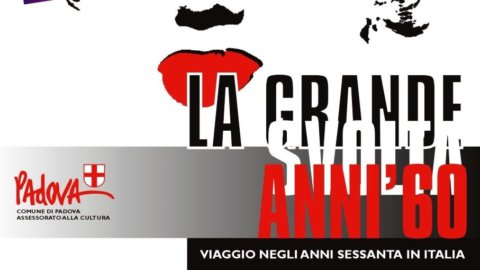The Department of Culture of the Municipality of Padua is organising, in the monumental spaces of the restored Palazzo della Ragione, a major event which intends to present the scenarios of the 60s by interweaving visual arts, design and architecture. The exhibition, curated by Virginia Baradel, Ennio Ludovico Chiggio and Roberto Masiero, will therefore take the form of a journey full of suggestions capable of surprising, exciting and making one think.
The installation curated by Italo Rota will transform the Salone (a real covered square of 2000 square meters with frescoes on astrological subjects) into a sort of global village that invites the viewer to cross the scenario of those years, pausing on the variety of works and objects exhibited or virtually.
Il Palazzo della Ragione which with its system of market squares and shopping arcades can be considered the first hypermarket in history, already born in the fourteenth century with this vocation, will therefore become the magnificent and restless landscape of the sixties for four months.
The decade that followed the years of Reconstruction became the most propulsive of the entire XNUMXth century. The events enclosed in those years profoundly changed every pre-existing structure. Science, the economy, technology and the arts underwent an epochal transformation, radically changing the way of perceiving and communicating reality.
The media and consumption became the two pillars upon which the face of mass society took shape. Advertising made desirable new products that were rapidly changing social and cultural mores. The new world of goods was born which drew motifs and formal strategies from the rich and extremely varied basin of artistic experimentation.
Padua and the Veneto were at the forefront in shaping the new horizons of shapes and goods; they contributed, with excellent figures, to the definition of models that would dictate the law in terms of aesthetic quality and design intelligence. This aspect will be investigated and presented in the context of the more general characteristics of the exhibition but with the aim of emphasizing the presence of artists as well as companies, events and valuable institutions that express a Venetian reality far removed from the clichés of a more next.
An extraordinary opportunity which will allow us to relive, between reason and emotion, this very important period of our recent past and which, by involving the most varied audiences, will offer ideas, emotions art and fashion, cinema and TV, music and design, architecture and more.
Cultural partners of the exhibition are theUniversity Institute of Architecture of Venice , Venice Biennale with whom a fruitful collaboration has been established.
Meetings and debates, music, shows and events will involve and excite the wider public.
"The 60s: the great turning point" on display in Padua
The monumental spaces of the restored Palazzo della Ragione are hosting a major event on the scenarios of the 60s which will transform the Salone into a sort of global village – the cultural partners of the exhibition are the University Institute of Architecture of Venice and the Venice Biennale with whom a fruitful collaboration has been established.





